达芬奇:从科幻小说里走来的机器人医生
|
“天呐,可别让我绊着什么东西。” 这是我小心翼翼地避过满地的电线走进手术室时的第一个想法。这是十月初的一个早上,我在纽约长岛的犹太医学中心,穿着一件婴儿式的蓝色连体防护服,头发和胡子都被捂得严严实实的,嘴上戴着口罩,鞋外面还戴了一层靴套。 穿上这些东西,显然不是为了方便,而是为了保护那个躺在离我五尺外的手术台上的病人。他裸露的身体上已经被医生开了几个小洞,那是癌症专家詹姆斯·苏利文医生和他的团队用来插入医疗器械用的。 然而这间手术室里除了苏利文医生之外还有另一位主刀医师,只不过这位医生穿得比我们任何人都舒服些。它的中央吊杆和白色的手臂上戴着塑料的“袖套”,这位医生就是Intuitive Surgical公司的“达芬奇Xi”机器人手术系统了。乍一看还真不好说这里谁说了算。 深入病人体内的仪器包括三个独立可互换的部件,它们可以切割、移动、抓握、烧灼甚至操纵人体组织。此外还有一个可移动的高清摄像机,它能以惊人的3D清晰度显示病人体内的情况。苏利文表示,这种视觉上的优势已经革命性地改变了医生进行微创手术的方式。现在医生们已经不需要把人开膛破肚来摘除某个组织或采集样本了。 |
“Oh, God, please don’t let me trip over anything.” That’s my first thought as I tiptoe around the electrical cords snaked across the operating room floor. It’s an early October morning at the Long Island Jewish Medical Center in New York. I’m decked out in a onesie-style baby blue protective suit, a hair mat, a bonnet to cover my beard, an additional mask for my mouth, and booties over my shoes. None of this is designed for agility. It’s meant to protect the patient lying on the table less than five feet away from me. His exposed torso is peppered with small holes through which cancer surgery specialist Dr. James Sullivan and his team insert their medical instruments. As it happens, there’s another surgeon in the room besides Sullivan—one more modestly garbed than either of us. Wrapped in plastic sleeves that cover its central boom and sprawling white arms is Intuitive Surgical’s da Vinci Xi robotic surgery system. It’s hard to tell who’s in charge. The instruments inside the patient include three separate, interchangeable components that can slice, shift, grasp, cauterize, or otherwise manipulate human tissue, as well as a movable high-definition camera that illuminates the body’s internal landscape in stunning 3D clarity. That’s a visual advantage that Sullivan says has revolutionized how doctors perform minimally invasive surgery—the kind that doesn’t require chopping someone open to remove a body part or collect samples. |
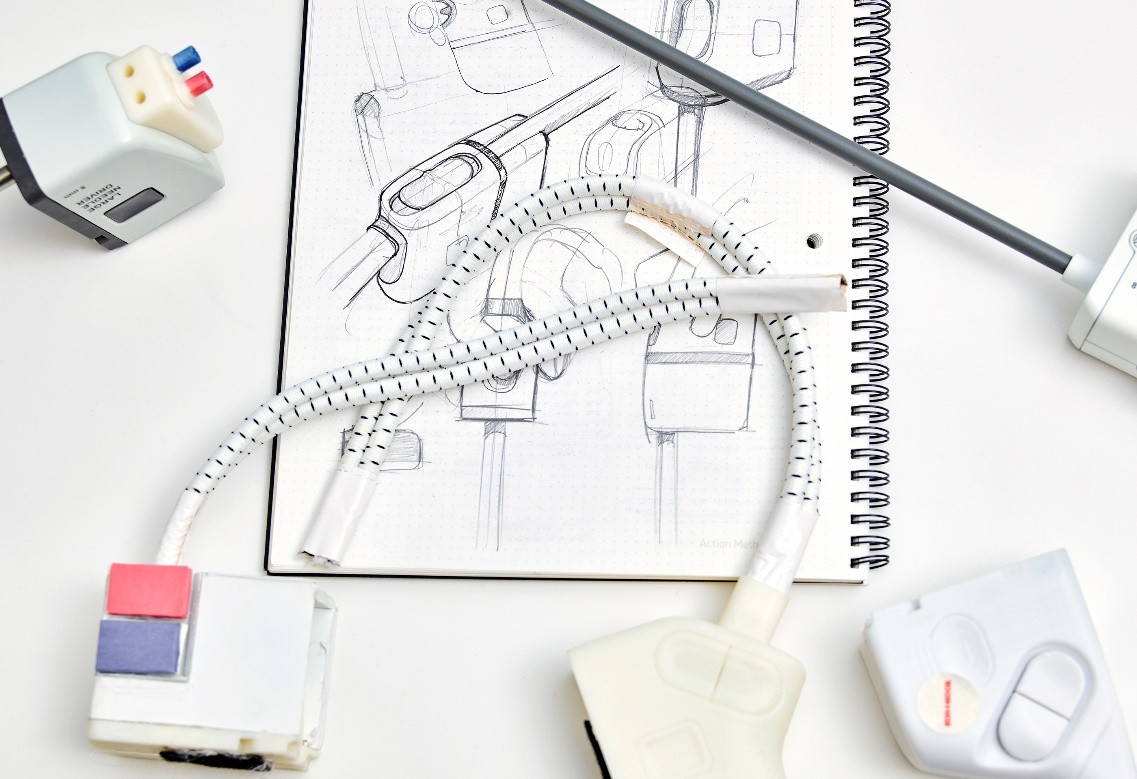
|
苏利文走到手术台左边的控制台,坐在了一个取景器前面。这个取景器很像某种具有未来主义色彩的游戏机的屏幕。他用两手的拇指和中指放到两个移动臂的圆环上,控制台的下面有几个踏板,看起来有点像手动档汽车的离合器。通过手指和脚的操作,苏利文就能控制这四个医疗器械在病人体内的活动,并且可以在手术器械和3D内窥摄像机间任意切换。 接下来的几个小时,他要使用达芬奇系统切掉病人的一个淋巴结进行病理分析(这个病人患有淋巴癌)。 两个小时后,我问苏利文,这个病人需要多久才能出院。 他反问我:“你住在什么地方?” “纽约布鲁克林的布什维克。”我答道。 苏利文笑了:“他可能比你先到家。” 科幻作品中历来不乏机器人医生的身影。虽然我们离“有病找安卓”的日子还有很远,但机器人参与手术却已经不是什么新鲜事了——当然,如果你不是外科医生的话,或许会觉得挺震惊的。加州森尼维尔市的Intuitive Surgical公司的机器人手术系统早在2000年就率先获得了美国FDA的批准,不过它的流行却还是最近几年的事。很多外科医生表示,该系统使他们能更清楚地看到病人体内的情况,同时也能对医疗器械进行更好的控制。 Intuitive Surgical 的设备现在已经广泛应用于美国所有的顶尖医院中,其应用领域涵盖了肿瘤科、泌尿科、妇科、消化科等等,美国许多顶尖医疗机构和院校,如纽约的纪念斯隆凯特琳癌症中心、梅奥诊所、约翰霍普金斯大学和克利兰医学中心等都采购了该公司的机器人手术设备。截止到今年6月30日,全球已有4100多台达芬奇系统投入使用,其中有2,703台在美国,698台在欧洲,538台在亚洲,还有210台分布在世界其他地区。 |
Sullivan makes his way to a console on the left side of the OR, where he takes a seat in front of a viewfinder that looks like it belongs in a futuristic video game arcade. He places his middle fingers and thumbs into two pairs of rings on two movable arms. At the console’s floor are foot pedals, which function like a clutch in a manual car. With his fingers and feet, Sullivan will navigate the four instruments now inside the patient’s body—alternating between the pincer-laden surgical extensions and a 3D endoscopic camera. Over the next few hours, he’ll use the da Vinci to cut out a lymph node from the patient (who suffers from lymphoma) for lab testing. Two hours later, I ask Sullivan how long it will be before the patient is discharged from the hospital. “Where do you live?” he asks. “Bushwick, in Brooklyn,” I reply. Sullivan chuckles. “He’ll be home before you.” Futurist culture has no shortage of fever dreams starring robot doctors. This story isn’t about that. While we’re still a ways from the day when androids become our go-to physicians, robotic surgery is already commonplace—and probably surprisingly so, if you don’t happen to be a surgeon. Intuitive Surgical (ISRG, -0.51%) , headquartered in Sunnyvale, Calif., got the first-of-its-kind clearance for its robotic surgical system from the Food and Drug Administration back in 2000. But it has been largely in the past few years that its machines have exploded in popularity. Surgeons who tout the tech say it’s given them a far clearer view of what’s happening inside the body and greater control over their instruments. Intuitive’s devices are now used at all of the top-ranked U.S. hospitals for cancer, urology, gynecology, or gastroenterology—including venerable institutions like New York’s Memorial Sloan Kettering Cancer Center, the Mayo Clinic, Johns Hopkins, and the Cleveland Clinic. More than 4,100 da Vinci base units have been installed worldwide as of June 30, including 2,703 in the U.S., 698 in Europe, 538 in Asia, and 210 in the rest of the world. |
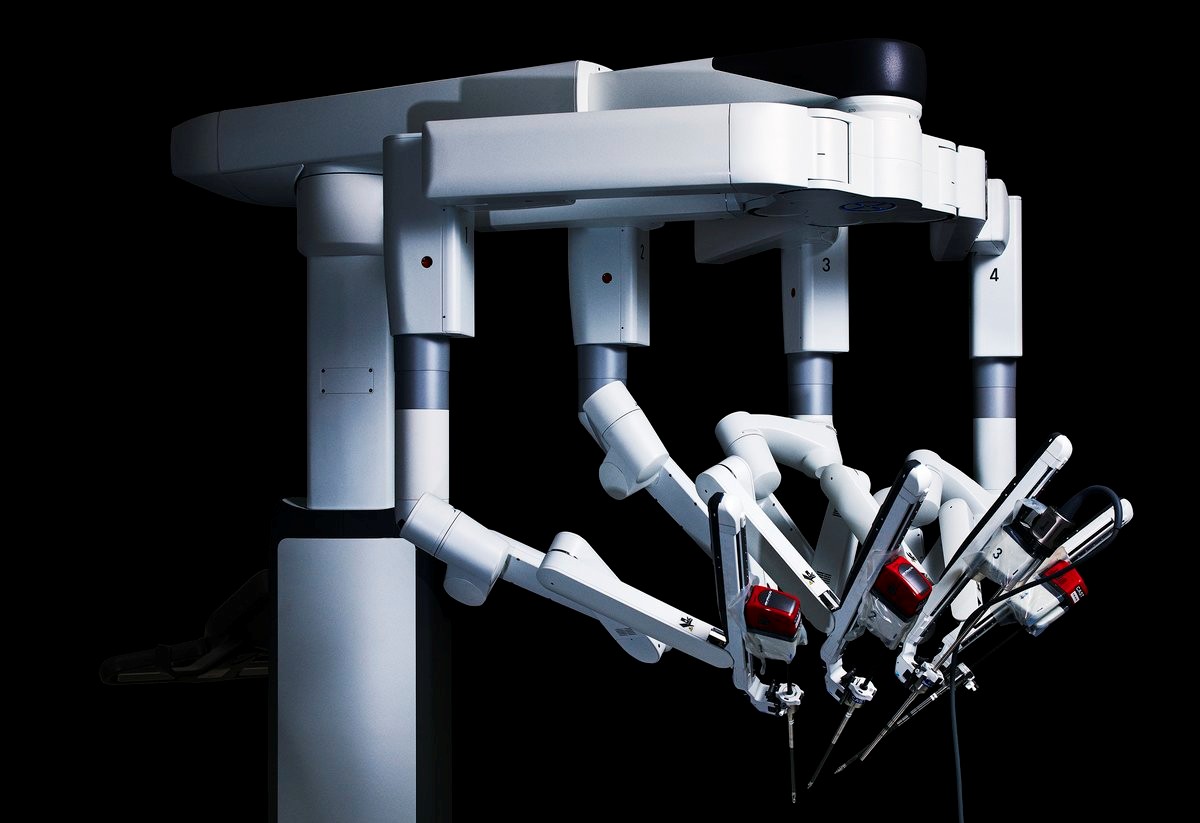
达芬奇手术机器人 照片:Spencer Lowell为《财富》拍摄
|
这样一套系统可是不便宜的,第四代达芬奇系统的单价是190万美元,还不包括各种手术配件的费用,这些配件的价格也高达数万美元。尽管如此,达芬奇系统的销路依然火爆,越来越多的医生都开始用它做手术了。 公司的CEO加里·古塔尔特告诉《财富》记者,自2000年以来,达芬奇系统已经完成了400余万例微创手术,全球每隔42秒钟就会启动一台由达芬奇系统主刀的手术。2016年,达芬奇系统在全球执行的手术数量较上年增长了15%,预计2017年还会在2016年的基础上继续增长14%到15%。对于某些较复杂的手术,比如前列腺彻底切除术等,由机器人辅助的手术已经占到了手术总量的近90%。 随着机器人外科医生的普及,2016年,Intuitive Surgical公司的全球营收入达到了27亿美元,其中有超过70%的销量是自然形成的,这也突显了该公司在这一快速增长的市场上作为先行者的优势。 达芬奇系统的火爆也吸引了投资人的关注。2017年,Intuitive Surgical公司的估值已经暴涨了70%,其市值已经接近400亿美元大关。 |
The systems aren’t cheap: The list price for the fourth-generation da Vinci Xi is $1.9 million, and that doesn’t include the cost of various surgical appendages, which can add tens of thousands of dollars more to the price tag. Still, the robots keep selling—and surgeons are increasingly adopting them in their practices. The company says that more than 4 million minimally invasive surgeries have been performed with da Vinci systems since 2000—a new one begins every 42 seconds somewhere around the globe, Intuitive CEO Gary Guthart tells Fortune. The number of those procedures done worldwide spiked 15% in 2016 compared with the previous year, and Intuitive pro¬jects an additional 14% to 15% rise in the number by the end of 2017. Indeed, for certain more complicated procedures, such as radical prostate removal, robotic-assisted surgeries now account for nearly 90% of operations. The boom has driven Intuitive to $2.7 billion in 2016 global revenue, with more than 70% of sales being recurring in nature—a fact that underscores the advantage that comes from being the first major player in a rapidly growing market. That’s been a draw for investors too; in 2017 alone, Intuitive’s valuation has soared more than 70%, pushing its market capitalization near the $40 billion mark. |
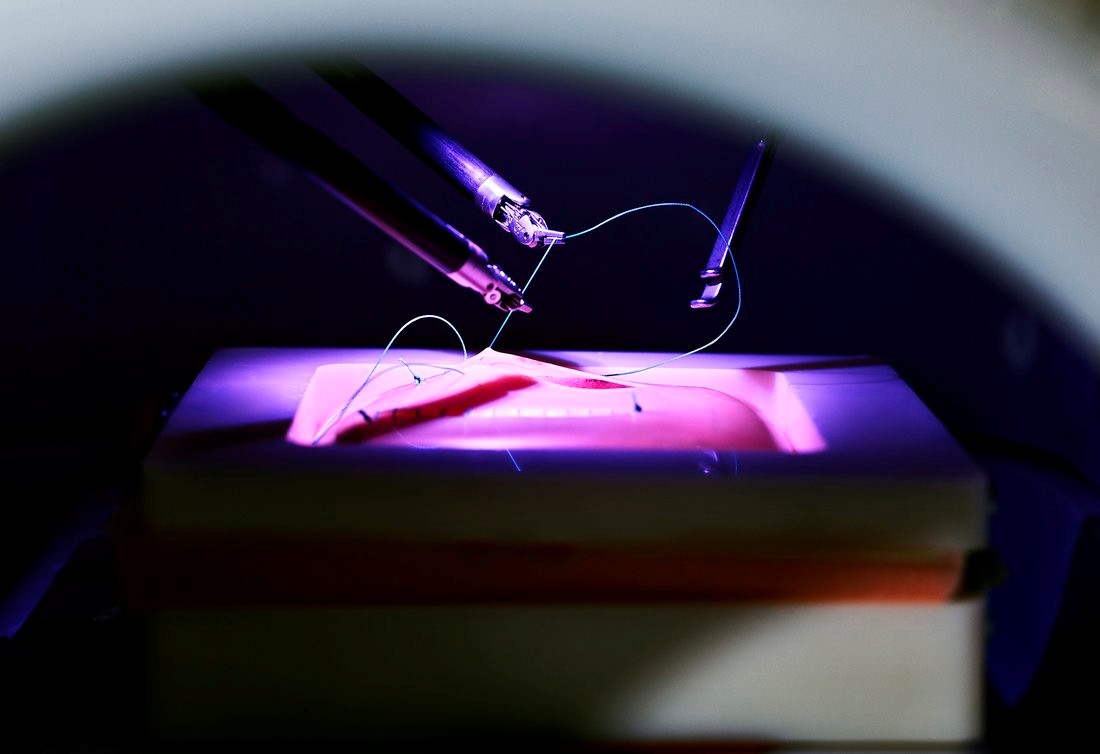
|
由于公司增长速度太快,自然会有人担心这种势头能否持续下去。不过有些密切关注这家公司的人相信,Intuitive Surgical的确把握了外科手术的未来发展方向。与此同时,这家公司也正在研制其他手术器械以进行更多类型的手术,同时公司也在积极向亚洲扩张,并且敢于主动走出“舒适区”,在癌症诊断领域进行探索。 比如该公司已与中国的复兴医药合资,探索在早期阶段诊断肺癌。他们开发了一种灵活的机器人导管,可以进入肺部的海绵状区域进行探查。已经追踪该公司达10年的摩根士丹利分析师大卫·刘易斯指出:“目前在肺癌治疗上的主要问题是,我们没有很好的工具进行诊断。我们经常不能及时发现肺癌,就是因为我们很难将医疗器械探进肺部,同时又不对病人造成伤害。” 刘易斯解释道,由于Intuitive Surgical的导管可以被精确追踪定位,因此可以更容易地识别出病灶。“我们认为,这种方法将彻底改革肺癌的治疗方法。” 马丁·韦泽是纪念斯隆凯特琳癌症中心的教育教学研发副主席兼主治医生,他表示:“有时候,如果某个东西效果更好,你自然会知道。”比如前些年内窥镜手术刚问世时就是这样。在进行内窥镜检查时,医生要用手将医疗器械和内窥镜通过小孔探入病人体内。不少医生迟迟没有学会这项新技术,尤其是那些上了年纪的医生。不过最终,内窥镜成了一种常见的手术方法。韦泽表示,机器辅助手术系统也会像内窥镜一样普及开来。“它既缩短了病人的住院时间,也使医生的手术过程更容易了,所以你知道它是个更好的东西。” 目前,我们还不敢断言机器人手术的质量一定优于人类医生。我们也不要指望从现有的医学文献中找到答案,因为很多研究的结论都是不统一的。但是有很多医生都愿意挥舞着他们的机器人手臂保证,同时他们对机器人系统也不乏溢美之辞。比如很多医生表示,接受机器人手术的病人往往恢复得十分迅速,而以往他们接受传统的开放式手术后,往往要住院恢复几天甚至几个星期才能出院。另外,摄像头的“清晰性”和医疗器械的“灵活性”也让很多医生赞不绝口。 |
The growth has been so breakneck that it’s natural to wonder if it can continue. But those who follow the company closely say they believe it can—that there is something truly intuitive about Intuitive’s grasp of the future of surgery. The company, meanwhile, is churning out new tools that can perform more kinds of operations, expanding feverishly into Asia, and experimenting well outside its comfort zone with cancer diagnostics. Intuitive has teamed up with China’s Fosun Pharma, for instance, in a joint venture to detect lung cancers in their earliest stages, developing a flexible robotic catheter that can navigate into the cavernous regions of the lungs. “The problem with lung cancer today is we don’t have great tools to diagnose it,” says Morgan Stanley analyst David Lewis, who has covered Intuitive for a decade. “We can’t always find it, because it’s hard to navigate something in the lung without doing damage to the patient.” Because Intuitive’s catheter can be tracked and targeted with pinpoint accuracy, it should make it easier to identify lesions with precision, Lewis explains. “We think this procedure will revolutionize the treatment of lung cancer,” Lewis says. “Sometimes, you just know when something’s better,” says Dr. Martin Weiser, an attending surgeon and a vice chair of education and faculty development at the Memorial Sloan Kettering Cancer Center, of robotic-assisted surgery. Such was the case when laparoscopic surgery debuted years ago. In laparoscopy, surgeons thread medical instruments and cameras by hand through small holes in the patient’s body. Surgeons, particularly older ones, were slow to adopt the new technology, largely because of the learning curve required. But eventually, it became common medical practice, says Weiser. The same has been true of robotic-assisted surgery, he says. “Whether it’s less time at the hospital for a patient or an easier time operating for a surgeon, you just know when it’s better.” It isn’t clear whether robotic surgery uniformly leads to better outcomes. (Don’t look to the extensive medical literature for a clear-cut answer; conclusions differ from study to study.) But surgeons who swear by their robotic arms tend to return to the same words of praise: They tout the “speed of recovery” for patients, who typically don’t need to spend days or weeks in a hospital as they might after traditional open surgery. They speak of the “clarity” of its camera, the “flexibility” of its instruments. |

一名Intuitive Surgical公司的工人正在组装机械臂
照片:Spencer Lowell为《财富》拍摄
|
当我终于有机会亲自上手测试达芬奇系统的训练模块时,一开始的时候,“灵活性”这个词当然是谈不上的。不过在一个装满了气球和硬币等小玩意儿的假体上练习了几分钟之后,我觉得我这双天生不太协调的双手似乎的确变得灵活了起来。不到十分钟,我就能操纵机器人在假人的胸腔里夹出一张5美元的纸币,并且把它递给另一个机械臂,而且我的手腕只要轻轻一翻,就能将它翻个面。(恰似苏利文形容的那样:“我好像长了四只手一样。”)也就是这时,我才第一次注意到了那张5美元纸币上的一些细节。纸币的背面绘着林肯纪念堂,林肯纪念堂顶部写着美国的26个州的名字,由于这些字太小了,我以前从来没注意到过。不过在达芬奇系统的摄像头下,这些州的名字却显得十分清晰。 不过在医学领域,再牛掰的技术,如果不能让詹姆斯(詹姆斯是苏利文的一个结肠癌病人,今年42岁,几个月前,苏利文刚刚切除了他的部分大肠)这样的病人切实受益,那也就跟耍杂技差不多。詹姆斯一开始对机器人手术有些疑虑,但在看了YouTube上的演示视频后,他还是选择了接受机器人手术。“我觉得它要么会做得非常完美,要么会非常糟糕,”他说。 手术后第4天,詹姆斯就出院了。短短三周后,他就返回了工作岗位。这与他父亲15年前的遭遇简直是天壤之别——虽然理论上他们父子俩接受的是同样的手术。“他们给他从胸骨到耻骨来了个大开膛,把所有东西都拿了出来,最后再放回去。所以他的恢复期要长得多,花了好几个月。” |
When I get the chance to test a da Vinci Xi training module myself, the word “flexibility” is the last one that would pop to mind. At first, anyway. But after a few minutes’ practice, “operating” on a plastic torso replica filled with balloons, pennies, and other knickknacks, even my own comically uncoordinated hands seem nimble, somehow. Within 10 minutes I was able to pick up a $5 bill inside the fake chest with one of the robotic pincers, pass it to the other one, and flip it around every which way with a flick of my wrist. (“It’s like having four arms,” as Sullivan puts it.) That’s when I learned a little something about the $5 note: On the back, which prominently features an illustration of the Lincoln Memorial, there are 26 states listed across the top of the building. The lettering is so small that I’d never noticed it before; under the da Vinci’s camera, the state names were sharp and clear. But in medicine, impressive technology is little more than a parlor trick if it doesn’t benefit patients—like James (who asked to keep his last name private), a 42-year-old colon cancer patient who had part of his large intestine removed by Sullivan a few months ago. James chose the robotic option, despite some initial apprehension, after watching some YouTube videos of the machine in action. “I figured this is either going to work out perfectly or it’s going to go really bad,” he says. He was discharged from the hospital four days after the operation and was back at work within three weeks. It was a far different experience than the one his father had 15 years ago—for what in theory was the same operation. “They cut him from his sternum to his pubic bone, peeled him open, and took everything out and put it all back,” James says. “So his recovery time was much, much longer. Months.” |
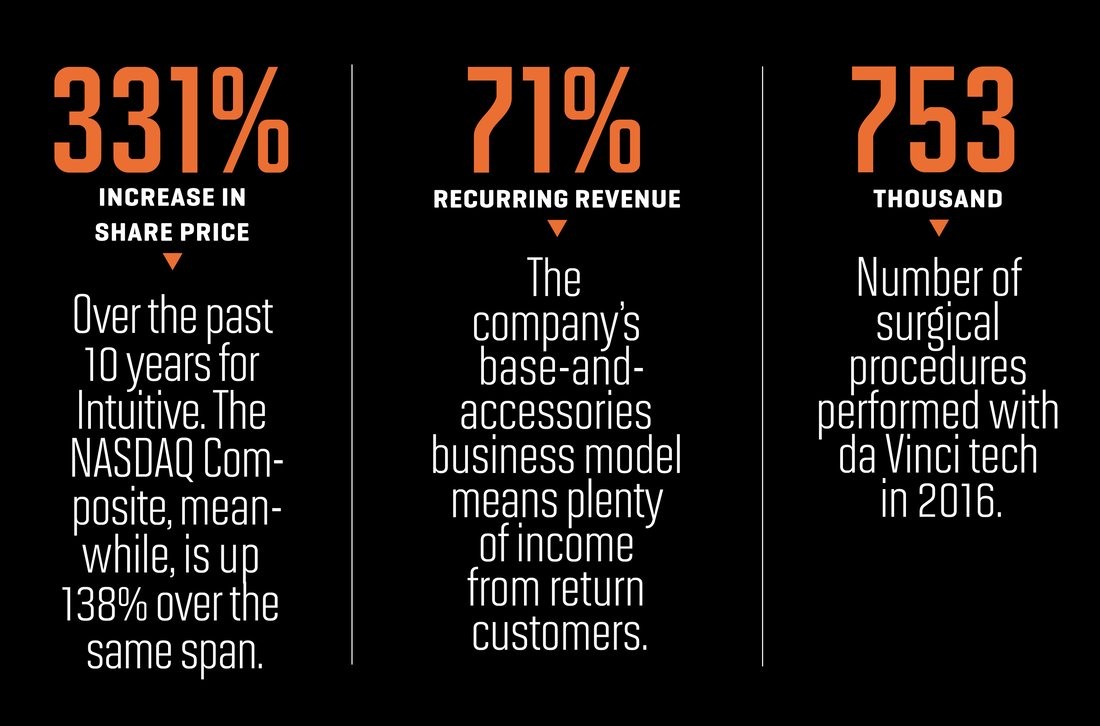
|
苏利文表示,虽然对于病人来说,是否接受机器人手术,对他们的医保报销没有任何分别,然而机器人手术无论对于病人还是对于医院,都是具有成本优势的。“很多人没有考虑过,这项技术改变了病人的住院时间。如果病人的住院时间从平均3.1天缩短到了2.1天,那就节省了不少成本。” 当然,每台近200万美元的单价,尤其对于一些对技术渴求度不高的市场,仍然不是一笔小数目。虽然学界对于机器人手术对病人的效果还有争议,但医学界基本已经认同,机器人辅助系统在执行一些复杂度较高的手术时确实是有优势的——比如治疗前列腺癌的前列腺切除术,这个手术要求精细地切除前列腺及其周边组织。实践也证明了达芬奇系统的功效:对于这种手术,机器人辅助手术确实既有益于患者,也更加节省成本。 Intuitive公司目前的一项重要战略,就是不仅仅向潜在病人进行宣传,更重要的是对年轻一代的外科医生宣扬机器人手术系统的优点,因为他们才是公司的下一代用户。 摩根士丹利的分析师大卫·刘易斯讲了这样一个故事,充分说明了外科学界的环境变化得有多快:就在五年前,在一次腹腔镜和内窥镜手术的专业会议上,“人们对Intuitive Surgical产品的接受度还很低,基本上在每个会议室里,你都能感受到,大多数医生都不赞成使用这个系统。”然而五年后,在同样的会议上,年轻的外科医生们已经在展示他们使用Intuitive机器人系统的一些数据了。 去年,投资和研究集团RBC Capital进行的一项调查发现,美国的外科医生认为,未来五年,35%的手术将有某种形式的机器人参与,而现在这一比例仅为15%。 |
While insurance reimbursement rates for patients are the same, in most cases, whether they opt for robotic surgery or not, there is nonetheless a difference in cost, says Sullivan—to both the patient and the hospital. “What really is never factored in is the fact that you’re changing the patient’s length of stay,” he says. “In a hospital, if your average length of stay is 3.1 days and you take that down to 2.1, that is a real cost savings.” But when it comes to the question of how quickly Intuitive can ramp up sales, particularly in less tech-hungry markets, the machine’s nearly $2 million price tag is no small factor. And while the academic debate over patient outcomes is a heated one, a rough consensus does emerge when it comes to more complicated surgeries—such as radical prostatectomy, where the prostate gland and some of its surrounding tissue is removed, usually to treat prostate cancer. Here, the verdict is in da Vinci’s favor: Robotic surgery tends to be both better for the patient and more cost-effective. A big part of Intuitive’s playbook is to evangelize that message not just with potential hospital customers, but¬—more important—with young surgeons who, the company hopes, will represent the next generation of its users. David Lewis, the Morgan Stanley analyst, shares an anecdote about just how quickly the surgical environment is changing. Five years ago, at a prominent meeting for laparoscopic and endoscopic surgeons, he says, “the reception to Intuitive Surgical was extremely poor. In fact you could sort of sense in any given room that physicians were almost frowned upon for their use of the system.” Five years later, that same meeting had been overtaken by young surgeons presenting data from their use of Intuitive robots. A survey by investment and research group RBC Capital last year found that American surgeons think that within five years, 35% of operations will involve robots in some form, compared with 15% today. |
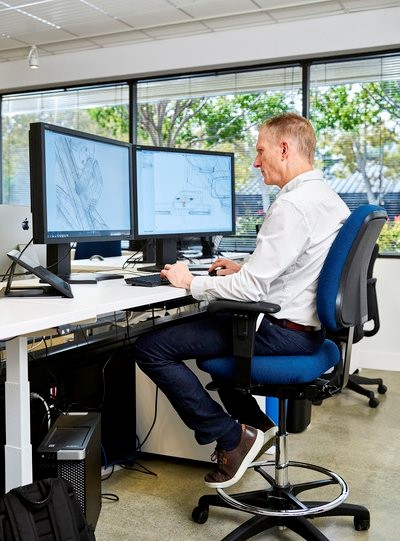
Intuitive Surgical的总部人员正在进行规划设计工作
照片:Spencer Lowell为《财富》拍摄
|
市场的扩大自然会带来竞争。过不了多久,美敦力公司和Verb Surgical公司(这是一个强生公司与谷歌母公司Alphabet的生命科学子公司Verily共同创办的手术机器人项目)都将推出自己的竞争产品。这两家公司的实力不容小觑,他们在世界各地的医院扎根很深,很有可能利用这些根深蒂固的关系,将自己的设备卖进手术室。 不过华尔街著名投行Leerink的医疗产品与设备研究部总经理理查德·纽维特却对Intuitive公司的未来表示乐观。他表示:“我们认为,竞争是对市场的一种检验,而且很可能会扩大市场的规模。” 摩根士丹利的刘易斯也认同这种观点。他认为,Intuitive公司的发展会经历三个阶段(不过他很快指出,这是他个人的预测,而不是Intuitive公司的预测)。第一阶段已经在进行了,就是要持续抢占美国、欧洲、亚洲的更多医院。“欧洲的机器人市场从很多方面看,至少落后美国三到五年。所以将这些技术打入欧洲市场,然后打入中国和日本等新市场,将是非常重要的。” 接下来的两个阶段则更引人注目,也蕴藏着最大的潜在增长机会。首先是“平台扩张”阶段,Intuitive要推出一系列新品或启动一系列研发。其中之一就是第五代的“达芬奇X”,它最近刚刚获得了FDA的许可,售价预计将比Xi便宜60万美元。它很可能会吸引那些不够财大气粗的医疗机构的眼球。 |
With an expanding market, naturally, comes competition. Both Medtronic and Verb Surgical (Johnson & Johnson’s joint robotic surgical project with Google parent Alphabet’s life sciences arm, Verily) are expected to challenge Intuitive with their own robotic surgery product lines. Those aren’t easy names to go up against; they have substantial footholds in hospitals around the world, and they may be able to leverage those long-standing relationships to elbow their devices into the OR. Richard Newitter, a managing director of the medical supplies and devices research unit at Leerink, is largely bullish on Intuitive’s future, however. “We think the competition is a validation of the market and potentially an expansion of it,” he says. Morgan Stanley’s Lewis agrees. He envisions three major phases of progression for Intuitive (though he’s quick to note that this is his prediction, not the company’s). The first phase, which is ongoing, is continuing to establish a presence in more hospitals in the U.S., Europe, and Asia. “European markets in many respects have lagged the U.S. robotic markets by three to five years if not longer,” says Lewis. “So taking these kinds of technologies into the European markets, and taking them into new markets like China and Japan, is going to be important.” But Lewis says the following two phases are more compelling—and where the greatest potential growth may emerge. First comes what he calls “platform expansion,” in which Intuitive pushes a number of new products that have either just entered the market or that are in the works. One is the da Vinci X, a system recently cleared by the FDA, which comes with a list price $600,000 cheaper than the Xi. Those units could attract hospitals that don’t have the deep pockets major cancer centers do. |
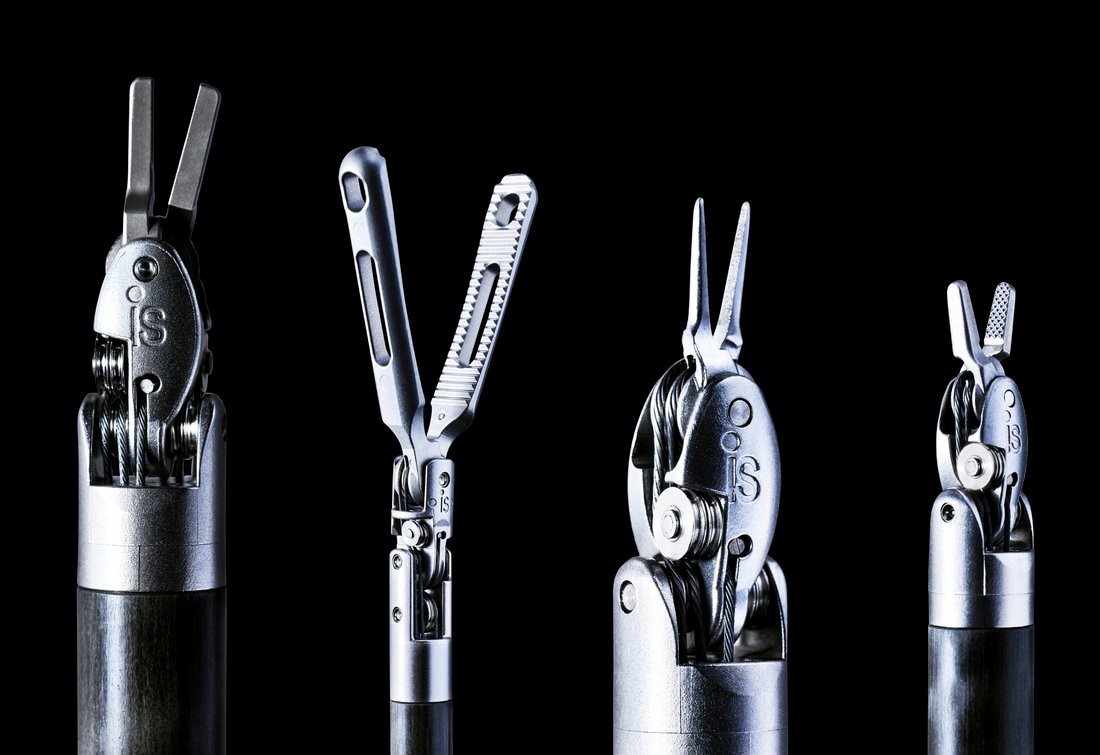
达芬奇系统的部分配件 照片:Spencer Lowell为《财富》拍摄
|
另一个重磅产品则是预计于2018年推出的“达芬奇SP”,刘易斯认为它很有可能是一款改变游戏规则的产品。SP是“单孔”(Single Port)的缩写。与有好几根机械臂的Xi不同,达芬奇SP系统只有一根机械臂,所以它只需要通过一个小孔就能进入人体,然后再展开它的四种工具。如果你看了它的演示视频,你可能会觉得这是某种外星生物。达芬奇SP大大提高了治疗某些口腔癌症的便利性,因为它可以通过口腔等人体的现有孔洞进行手术,从而减少了对患者的侵入创伤。(而传统手术方法有时要在病人颈部开刀。)在今年五月的一份报告中,刘易斯等人估计道,到2025年,每年使用这种新型机器人系统进行的手术或将多达17万例。 接下来是第三阶段,即Intuitive公司有可能将各种各样的类似技术整合到一个单一的平台。刘易斯想象道,未来的机器人手术系统或将拥有更先进的成像技术,能够突出身体的更多细节,使外科医生能够立即区分不同的血管和神经。另外,有些机器人系统还应该能直接在控制台上显示病人的病史,或者可以在进行当前手术的同时,用视频回看病人之前的手术过程。 这些可能听起来像是科幻小说里的情节,但就在短短10年前,机器人手术的理念不也还是科幻小说里的构思吗? 机器学习:医疗保健领域的3大创新科技理念 近年来,许多医疗技术领域的创业者借鉴了一些科幻小说里的情节,并把它们变成了现实。 |
Another, which Lewis calls a potential game changer, is the da Vinci SP, expected to be released in 2018. “SP” stands for “single port.” Rather than the four, spiderlike arms of the da Vinci Xi, the da Vinci SP has just one arm, inserted into one hole in the body, through which four different maneuverable tools emerge. Watch a video of the machine in action and you will likely think it’s some alien creature. The SP, for instance, could enable surgeons to treat certain oral cancers far less invasively because the port can be inserted through an existing orifice such as the mouth. (By contrast, in some cases, traditional surgical approaches require splitting open a large portion of a patient’s neck.) In a May report, Lewis and colleagues estimated that, by 2025, surgeons could perform as many as 170,000 new robotic procedures annually using the instrument. Then comes phase three, according to the Morgan Stanley analyst: That’s where Intuitive could potentially bring together all sorts of buzzy technologies under a single platform, Lewis says. He imagines robotic systems with more advanced imaging that can highlight the body in even greater detail, enabling surgeons to instantly differentiate between individual blood vessels and nerves. Or those that incorporate a patient’s medical history right on the console. Or video that allows surgeons to replay past procedures during a current one. All of that may sound like the stuff of science fiction. But then, 10 years ago, so did the idea of a robot surgeon. Machine Learning: 3 Novel Tech Ideas in Health Care Medtech entrepreneurs are taking ideas from science-fiction novels and bringing them to life. |

|
Catalia Health:提醒你不要“吃错药”的机器人伴侣。 “吃错药”这件事每年给社会带来的代价高达3000亿美金。但是有了这个可爱的黄色小机器人,妈妈再也不用担心我吃错药了。Catalia Health公司推出的Mabu机器人是一个由人工智能技术驱动的机器人医疗伴侣,它不仅能与患者聊天解闷儿,还能提醒他们按时吃药。 Hololens:用VR技术培训医生。 目前方兴未艾的VR和AR技术不仅仅能用来打游戏。凯斯西储大学和克里夫兰医学中心就正在使用微软的Hololens教医学生学习解剖学。利用VR全息技术,学生可以从各种角度操纵“器官”和“骨骼”,从而更加真实地看到人体内部的情景。 Woebot Labs:聊天机器人疗法。 如果你有心理问题,又请不到(或者请不起)心理医生,不妨试试Woebot。它是斯坦福大学研发的一个聊天机器人,在Facebook Messenger上就可以全天使用。它会关心地询问你的感受,建议你怎样才能感觉好些,甚至偶尔讲几个笑话。它也算是AI时代的谈心疗法了。(财富中文网) 译者:贾政景
本文另载于2017年11月1日的《财富》杂志上。 |
Catalia Health: A robo-nag for your medications. What if a cute little yellow robot could help solve a $300 billion health care problem: people failing to properly take their prescription drugs? That’s what Catalia Health has set out to do with Mabu, an A.I.-driven robotic medical companion that makes small talk with patients—and gives them timely reminders to take their meds too. Hololens: Using VR to train MDs. Augmented and mixed reality aren’t just for gaming. Case Western Reserve University and the Cleveland Clinic are designing programs that use Microsoft’s HoloLens to teach med students anat¬omy. With holograms, students can manipulate organs and bones from every conceivable angle and get an immersive look at the body’s internal landscape. Woebot Labs: Chatbot therapy. Couch optional For those who can’t get an appointment with their therapist (or can’t afford one), there’s an alternative. Woebot, a chatbot developed at Stanford, will work through your issues 24/7 via Facebook Messenger. It will ask how you’re feeling, recommend ways to feel better, and even share the occasional joke. Think of it as talk therapy for the A.I. age.
A version of this article appears in the Nov. 1, 2017 issue of Fortune with the headline “Coming to an O.R. Near You.” |











